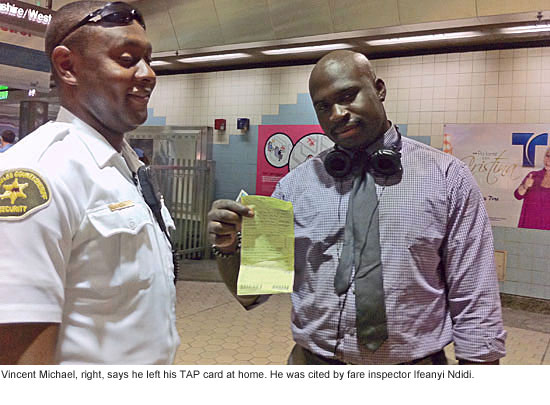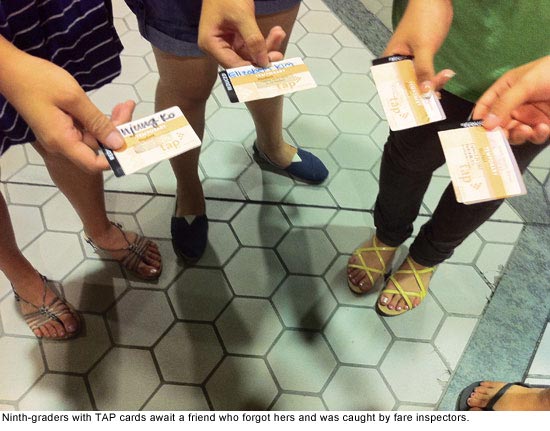Better buy a ticket to ride
October 13, 2011
 For Conrad Armour, the free ride came to an end Wednesday.
For Conrad Armour, the free ride came to an end Wednesday.
Not that the 23-year-old student was intentionally trying to evade the subway fare; he swears he inadvertently left his monthly pass in his gym locker. But on this particular afternoon, a gym locker was the worst possible place for that pass to be.
Metro officials, preparing for the first time to bring locked turnstile gates to local subway lines, are conducting a pilot test in four stations this month. That means spot-checking passengers’ tickets as they get off trains and monitoring ticket sales as incoming patrons realize they’ll have to pay to ride, or face the consequences. (A ticket for fare evasion can mean a $250 fine.) The test run is intended to explore, among other things, how many fare evaders the locked gate system could turn into paying customers.
As incredible as it might seem to transit riders from other big cities like New York and San Francisco, where locked gates are the time-honored way to prevent or at least slow down fare-beaters, Los Angeles’ subway was designed to operate on the honor system.
In recent years, Metro has taken steps to change that. In 2008, the agency’s board approved installation of a $46 million barrier gate system for L.A.’s Red Line and Purple Line subways as well as some light rail lines. At the time, it was estimated that fare-beaters cost the system $5.5 million a year, and that the system would begin paying for itself in its fourth full year of operation.
By last year, the turnstile gates were all installed but have remained unlocked while the agency tries to figure out how best to implement the new system. Still-unresolved issues include finding ways to handle passengers with paper tickets instead of the widely-used TAP “smart cards” that are designed to open the gates, and to incorporate travelers from other local transit lines that haven’t become part of the TAP network.
There’s also been debate over how far the amount of additional ticket revenue will actually go toward offsetting the cost of changing the system.
On Wednesday, Metro’s team directed patrons coming into the Purple Line’s Wilshire/Western station based on whether they had a TAP card, a paper ticket or no ticket at all. Vending machines appeared to do a brisk business selling to customers who may or may not have been planning to pay.
“It’s a lot more than a handful,” observed Supervisor Zev Yaroslavsky, who dropped by the station Wednesday as part of a small delegation of Metro board members including Santa Monica Councilmember Pam O’Connor, Lakewood Vice Mayor Diane DuBois and representatives from the office of Los Angeles Mayor Antonio Villaraigosa.
As part of the operation, fare enforcement officers were on hand to spot-check for tickets as passengers got off the trains.
While many people showed legitimate tickets or cards, many others did not. And the excuses were flying.
“The stories—some of them are good,” said Daniel Pickering, who along with Ifeanyi Ndidi was checking to make sure people had paid their fares.
Pickering said the body language could be a tip-off, with some patrons putting on an elaborate show of patting down their pockets, avoiding eye contact or rushing by flashing just the back of a ticket.
Some passengers—with and without tickets—got flustered.
“Where is that ******* ticket I got for $5?” one woman said as she angrily rummaged through her things before finally producing a ticket and hurrying on her way.
Another was escorted out of the station in handcuffs after a loud and lengthy exchange that escalated after she refused to sign her citation for fare evasion. (A sheriff’s patrol car was summoned but the woman was released after she finally decided to sign.)
The fare inspectors had the discretion to issue a warning or a citation. For example, a visiting student from France, Nathalie Karouni, was given the chance to purchase a ticket instead of getting a citation. And Isaac Taez, an 18-year-old student at the Friedman Occupational Center, got off with a warning.
Other travelers were slowed down a bit, like the 9th grade girls who had to wait for the one member of their group who’d forgotten her TAP card Wednesday and had to explain herself to the fare inspectors.
Sgt. Jeff Jablonsky, the sheriff’s department’s liaison to the TAP card/gating program, said 53 citations have been given out during the test program so far, with more likely next Wednesday, October 19, when all four of the test stations will be operating with locked gates from 1 p.m. to 4 p.m. (The stations are Wilshire/Normandie and Wilshire/Western on the Purple Line, and Vermont/Beverly and Hollywood/Western on the Red Line.)
In addition, he said, 5 people have been arrested, including a suspected graffiti vandal and a suspect with an outstanding warrant for a narcotics violation.
Jablonsky said that from what he’s heard, the transit-riding public supports locking the gates. “The comment that we’ve heard most of the time is, ‘It’s about time,’ ” Jablonsky said. “And we have other ones who say ‘I’m from New York and our gates are locked all the time. I don’t understand why your gates aren’t locked.’ The public is ready for it.”
That seemed to be the prevailing sentiment among travelers Wednesday. “I use the train, so I should pay for it. Otherwise I should walk,” said Sacha Larrabee, a 33-year-old grad student at Azusa Pacific University.
“It’s better because usually people come down here with nothing—no money, no TAP card,” said Alex Avalos, 18. “It’s like it’s free!” agreed Alyssa Segarra, 19.
Even some of those cited seemed more resigned than angry.
“I have a bus pass!” said Armour, the student who said he’d left the pass in his gym locker. “Unfortunately I just got caught up in it.” He said he was confident he could convince a judge to throw out the ticket when he produces the pass.
Vincent Michael, a 22-year-old security officer, said he also plans to fight his citation.
“I have a TAP card, a valid one, and I forgot it at home today, so I’ll just take it to court,” he said, before offering his support for the locked-gate project.
“It keeps everybody on their toes,” he said. “It makes everybody pay the fare.”
Posted 10/13/11













 405 bridge work causes a stink
405 bridge work causes a stink

